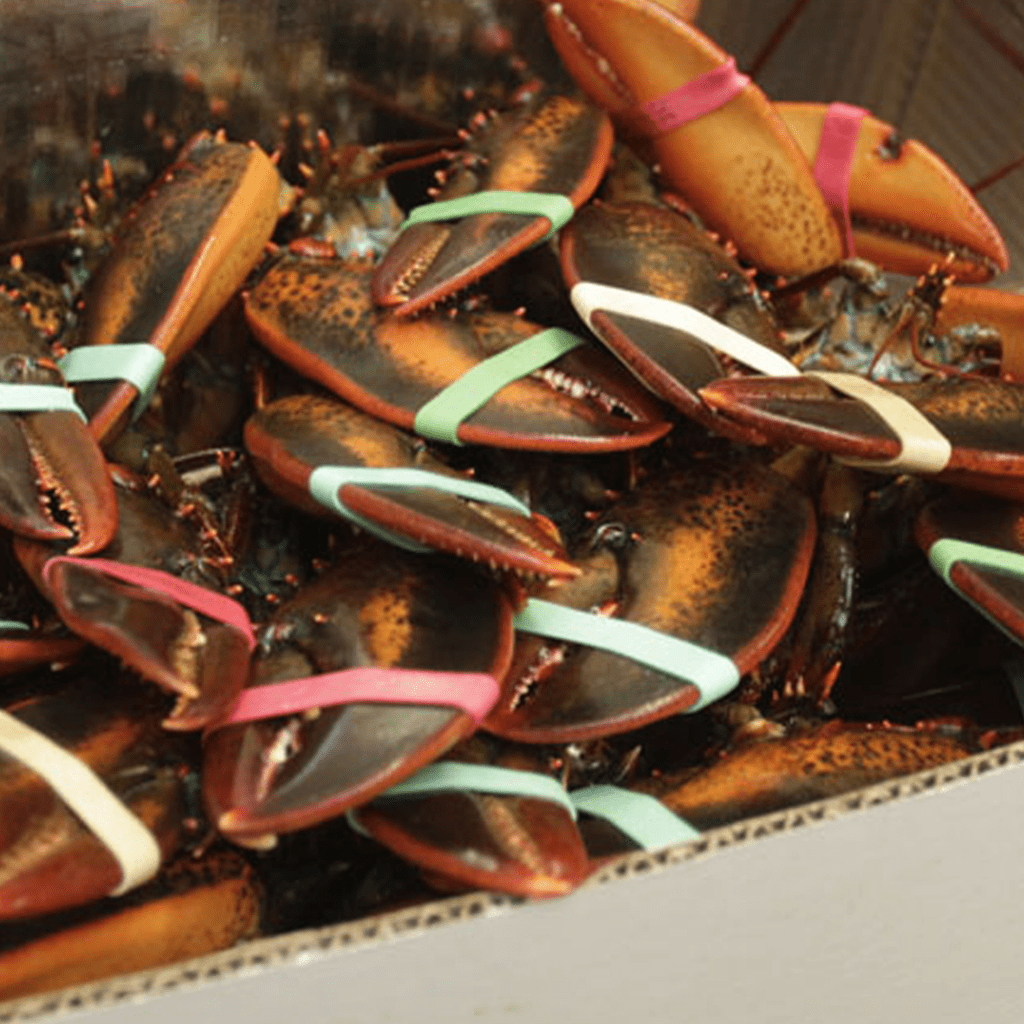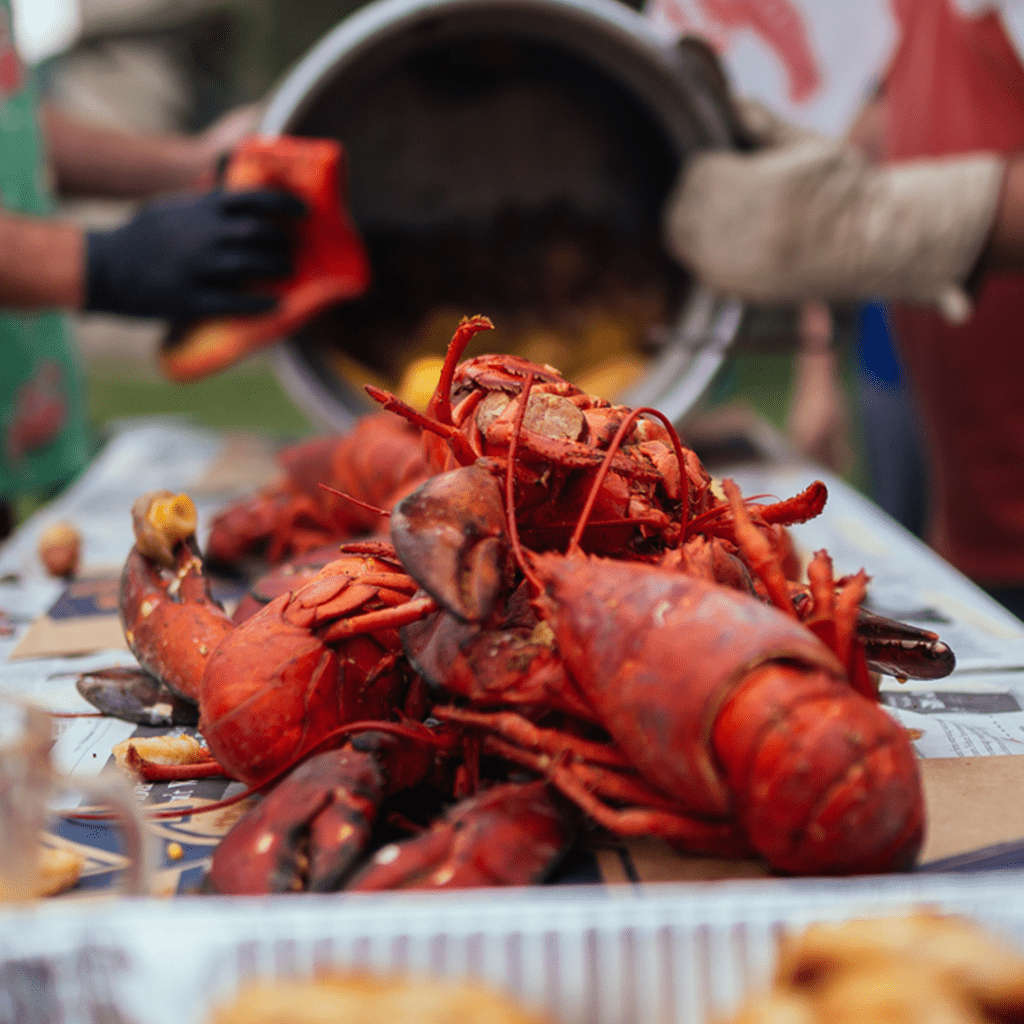Handling Lobster
Succulent and sweet, Canadian lobster is one of the most sought-after seafood in the world. Known as “the King of Seafood,” the Homarus Americanus is prized for its hard shell, full-meat qualities and large claws. Found in the pure and icy waters of Canada’s Atlantic Ocean, Canadian lobster is one of the most delicious and nutritious sources of protein you can find. It’s the star of any dining experience whether it’s simply boiled and served with butter, grilled on the barbecue or featured in a creamy chowder. Canada’s lobster fishery is sustainable and steeped in tradition, with independent fishermen harvesting these wild crustaceans for your plate. If you are in the food service industry or just love lobster, check out these resources on Canadian lobster.
Download the Food Service Guide (PDF)Live Lobster
Handling
Live lobster will keep 36 to 40 hours out of water in a cool damp environment such as an open container in a refrigerator, and if their gills are kept moist with dampened newspapers or towels. As a saltwater creature, make sure lobsters are not exposed to fresh water of any kind, ice or otherwise. Live lobsters will arrive with elastic bands around their claws to protect handlers, which you may remove before or after the lobster is cooked.
After cooking, you may refrigerate lobsters in airtight containers for up to three days if not eaten right away. Meat removed from the shell will last a little longer, for up to four days in the refrigerator. You may also freeze cooked lobster meat for use at a later time—leftovers are perfect to add to a chowder or stew.
Buying
Whether directly from a pound, a store, or shipped, lobster must be cooked live. The fresher it is, the livelier it will be—in prime condition, a live lobster will move its claws or snap its tail. Any sluggish lobster should be cooked immediately, and non-responsive lobsters that may be dead should be discarded.
Lobsters come in various sizes from canners (1/2 pound to 1 pound) to jumbos (over 2 1/2 pounds). A 1 1/2 pound hard-shell lobster will yield approximately 1 1/3 cups of cooked meat. When live, Canadian Lobsters are of many hues, from a dark greenish blue to brownish olive. Regardless of shell color, all cook up red and with the same texture and excellent flavour.
Cracking a Canadian Lobster
When it comes to celebratory feasts, nothing offers more sleeves-rolled-up entertainment than a lobster boil. You’ll find that Atlantic Canadians have many ways of cracking a lobster, but here are the basics for those new to this uniquely delicious feast.
Dress the table for a bit of a mess, and provide bibs or good-sized napkins or dishtowels. Be ready for the odd squirt and a lot of laughter as the table digs in! Some of us start with the claws, while others jump in with the tail. Some of us crack and eat as we go, and others do all the de-shelling first, making a neat pile and cleaning the plate for potato salad or corn on the cob. If you’re not watching your waistline, make sure there’s lots of melted dipping lemon butter on-hand, with a small ramekin for each. And don’t forget a great big shells bowl for everyone to reach in the middle, to discard as you eat.
Twist the tail
To begin with the tail, grasp the lobster around the body with one hand and the tail with the other and gently twist. Pull apart the two pieces. Do this over the shells bowl—expect some water with this twist!
Twist the tail
To begin with the tail, grasp the lobster around the body with one hand and the tail with the other and gently twist. Pull apart the two pieces. Do this over the shells bowl—expect some water with this twist!
[NOTE: You may notice a green substance on the tail meat which is called the tomalley. If you see a waxy red clump, that’s roe (eggs)—you’ve got yourself a female. Both are edible and considered by many to be one of their favorite parts, but many other people scrape them off or tap them into the shells bowl. Your choice!].
Next, cradle the tail in your palm and squeeze both sides together until you hear and feel the shell crack. Then place your thumbs on each side of the tail and force it open like a book to remove the meat.
Frozen Lobster Meat
Modern processing methods lock in the highest quality and flavour, straight from the boat. In order to maintain this high quality, it is important to handle frozen lobster meat with the utmost care and respect.
First, make sure processed lobster meat is fully frozen when you purchase or receive it. If it’s warmer than -18°C (0°F) it may be compromised, but as long as it stays under -26 to -30°C (-15 to -20°F), frozen lobster can be stored with no quality loss for up to nine months. As with any frozen seafood, keep it away from the freezer walls and off the floor for good air circulation.
Thawing
Place unopened cans or pouches of frozen lobster meat in cold water in the refrigerator. Thawing times vary according to package size, but allow for about two hours per pound. To thaw whole frozen lobster in brine, use the same method, but plan for three to five hours per package for thawing. Separate frozen whole lobsters on a tray in the refrigerator.
Do not thaw frozen lobster meat in warm water, or at room temperature. This causes quality loss and drip loss. If you’re in a hurry, small packs can be set under cold running water. Remember that frozen lobster products are not shelf stable unless they’re frozen, and consume lobster meat within 24 to 36 hours of thawing.
Preparation
Once thawed, open the package or can and thoroughly drain the meat. Pre-cooked meat is ready to eat, requiring only reheating. Check out our Tasty Recipes for delicious lobster dishes—many can substitute fresh frozen lobster meat in place of live lobsters. Have fun and experiment!
Lobster Tails
It’s easy to find previously frozen lobster tails at a local fish counter or through your distributor. To begin, ensure the tails are fully defrosted. If they’re still frozen, you can follow the instructions for Frozen Lobster Meat above to defrost.
Preparation
Lobster tails are full of meat so plan 4-6 ounces per serving. Tails are incredibly versatile and can be broiled, grilled or simply served boiled or steamed with plenty of clarified butter.

More to explore



Our Industry

Lobster 101


